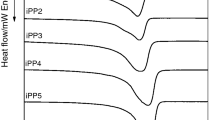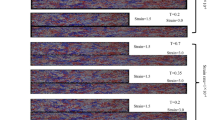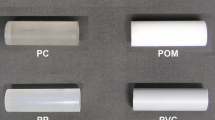Abstract
A study of methodological nature demonstrates the efficiency of a probation test allowing for the intrinsic character of a rheological constitutive law to be assessed. Such a law is considered here for semicrystalline polymers exhibiting necking and for large deformation. In the framework of a law of behavior of \(( \dot{\sigma },\sigma , \dot{\varepsilon },\varepsilon )\), tensile experiments conducted at an imposed constant strain rate \(\dot{\varepsilon }_{0}\) bring true stress responses, from which the constitutive (material) parameters can be identified from model-based metrology concepts. The same experiment repeated at various strain rates gives an access to the dependence of the nonelastic parameters on the strain rate. Then the intrinsic law is tested severely by considering a new set of experiments carried out for constant displacement rates of the grips. In that case the specimens show local strain rates that evolve strongly during the test (by a factor of 5–10). The parameter identification process requires the introduction of the exact realized input strain and strain-rate command into the model. Accounting for strain rate dependency additionally requires the knowledge of the preliminary identified strain rate dependence of the nonelastic constitutive parameters for good predictions of the experimental response directly. This is what is proven here. The conclusion speaks in favor of a possible upgrade of international standards for the mechanical characterization of polymers based on constant strain-rate tensile tests and properly applied model-based metrology.







Similar content being viewed by others
References
André, S., Meshaka, Y., Cunat, C.: Rheological constitutive equation of solids: a link between models based on irreversible thermodynamics and on fractional order derivative equations. Rheol. Acta 42, 500–515 (2003)
Arruda, E.M., Boyce, M.C.: A three-dimensional constitutive model for the large stretch behavior of rubber elastic materials. J. Mech. Phys. Solids 41(2), 389 (1993)
Aster, R.C., Borchers, B., Thurber, C.H.: Parameter Estimation and Inverse Problems, 2nd edn. Academic Press, San Diego (2013)
Beck, J.V., Arnold, K.J.: Parameter Estimation in Engineering and Science. John Wiley & Sons, New York (1977)
Blaise, A., Andre, S., Delobelle, P., Meshaka, Y., Cunat, C.: Advantages of a 3-parameter reduced constitutive model for the measurement of polymers elastic modulus using tensile tests. Mech. Time-Depend. Mater. 20(4), 553–577 (2016)
Cunat, C.: A thermodynamic theory of relaxation based on a distribution of non-linear processes. J. Non-Cryst. Solids 131(133), 196–199 (1991)
Cunat, C.: The DNLR approach and relaxation phenomena, part I: historical account and DNLR formalism. Mech. Time-Depend. Mater. 5, 39–65 (2001)
De Donder, T.: Thermodynamic Theory of Affinity: A Book of Principle. Oxford University Press, London (1936)
Faccio-Toussaint, E., Ayadi, Z., Pilvin, P., Cunat, C.: Modeling of the mechanical behavior of a nickel alloy by using a time-dependent thermodynamic approach to relaxations of continuous media. Mech. Time-Depend. Mater. 5, 1–25 (2001)
Farge, L., Boisse, J., Dillet, J., André, S., Albouy, P.-A., Meneau, F: WAXS study of the lamellar/fibrillar transition for a semi-crystalline polymer deformed in tension in relation with the evolution of volume strain. J. Polym. Sci., Part B, Polym. Phys. 53, 1470–1480 (2015)
Haward, R.N.: Strain hardening of thermoplastics. Macromolecules 26, 5860–5869 (1993)
Haward, R.N.: Strain hardening of high density polyethylene. J. Polym. Sci., Part B, Polym. Phys. 45, 1090–1099 (2007)
Laiarinandrasana, L., Besson, J., Lafarge, M., Hochstetter, G.: Temperature dependent mechanical behaviour of PVDF: experiments and numerical modelling. Int. J. Plast. 25(7), 1301–1324 (2009)
Lion, A.: On the thermodynamics of fractional damping elements. Contin. Mech. Thermodyn. 9, 83–96 (1997)
Maillet, D., André, S., Rémy, B., Degiovanni, A.: Regularized parameter estimation through iterative rescaling (PETIR): an alternative to Levenberg–Marquardt’s algorithm. (2013) HAL Id. hal-00867608 https://hal.archives-ouvertes.fr/hal-00867608
Na, B., Lv, R., Xu, W., Yu, P., Wang, K., Fu, Q.: Inverse temperature dependence of strain hardening in ultrahigh molecular weight polyethylene: role of lamellar coupling and entanglement density. J. Phys. Chem. B 111(46), 13206–13210 (2007)
Neghaban, M., Goel, A., Delabarre, P., Feng, R., Dimick, A.: Experimentally evaluation the equilibrium stress in shear of glassy polycarbonate. J. Eng. Mater. Technol. 128, 537–542 (2006)
Pardoen, T., Hutchinson, J.W.: An extended model for void growth and coalescence. J. Mech. Phys. Solids 48(12), 2467–2512 (2000)
Prigogine, I., Defay, R.: Thermodynamique chimique conformément aux méthodes de Gibbs et De Donder, Tome II. Gauthier-Villars, Paris (1946)
Sorvari, J., Hämäläinen, J.: Time integration in linear viscoelasticity – a comparative study. Mech. Time-Depend. Mater. 14, 307–328 (2010)
Tervoort, T.A., Govaert, L.E.: Strain-hardening behavior of polycarbonate in the glassy state. J. Rheol. 44, 1263 (2000)
Treloar, L.R.G.: The Physics of Rubber Elasticity. Clarendon Press, Oxford, UK (1975)
Van Melick, H.G.H., Govaert, L.E., Meijer, H.E.H.: On the origin of strain hardening in glassy polymers. Polymer 44(8), 2493–2502 (2003)
Walter, E., Pronzato, L.: Identification of Parametric Models from Experimental Data. Springer, Heidelberg (1997)
Ye, J., Andre, S., Farge, L.: Kinematic study of necking in a semi-crystalline polymer through 3D digital image correlation. Int. J. Solids Struct. 59, 58–72 (2015)
Acknowledgements
The authors wish to acknowledge Jérémy Bianchin for technical assistance at LEMTA lab. The authors gratefully acknowledge financial support from different research programs involving the CPER “SusChemProc” of Grand-Est Region, the CNRS “PEPS” programs 2018 and 2019, the CARNOT label for its specific financial support #ICEEL-2019, and the EMPP Research Axis of Lorraine University.
Author information
Authors and Affiliations
Corresponding author
Additional information
Publisher’s Note
Springer Nature remains neutral with regard to jurisdictional claims in published maps and institutional affiliations.
Rights and permissions
About this article
Cite this article
André, S., Becker, S., Farge, L. et al. Certifying the intrinsic character of a constitutive law for semicrystalline polymers: a probation test. Mech Time-Depend Mater 25, 645–661 (2021). https://doi.org/10.1007/s11043-020-09466-w
Received:
Accepted:
Published:
Issue Date:
DOI: https://doi.org/10.1007/s11043-020-09466-w




